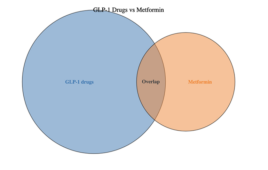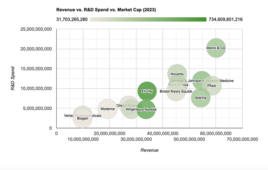 Emerging from stealth in late 2022, Palo Alto–based biopharma startup OrsoBio announced four development programs targeting severe metabolic disorders. The CEO and founder, Dr. Mani Subramanian and chief medical officer and head of development Dr. Rob Myers formerly worked at Gilead. Founded in 2020 with a quest to “try to modulate energy metabolism in severe metabolic disorders like obesity, diabetes, dyslipidemias, NASH, etc.,” as Myers put it, the company focuses on drug targets that affect fundamental aspects of mitochondrial function.
Emerging from stealth in late 2022, Palo Alto–based biopharma startup OrsoBio announced four development programs targeting severe metabolic disorders. The CEO and founder, Dr. Mani Subramanian and chief medical officer and head of development Dr. Rob Myers formerly worked at Gilead. Founded in 2020 with a quest to “try to modulate energy metabolism in severe metabolic disorders like obesity, diabetes, dyslipidemias, NASH, etc.,” as Myers put it, the company focuses on drug targets that affect fundamental aspects of mitochondrial function.
To date, OrsoBio has completed a $60 million Series A financing round, bringing its total fundraising total to $97 million. Longitude Capital and Enavate Sciences co-led the fundraising, with significant participation from existing investors Samsara BioCapital and NuevaBio. The round also brought in a notable new investor — Eli Lilly. Lilly’s stock has nearly doubled over the past year, thanks in part to its FDA approval of the dual GIP/GLP-1 receptor co-agonist tirzepatide for treating obesity.
OrsoBio targets mitochondrial biology for metabolic disorders

Dr. Rob Myers
The surge in demand for glucagon-like peptide-1 (GLP-1) receptor agonists in recent years reflects a growing acknowledgment of the role of incretin biology in metabolic diseases. But with more than 42% of the U.S. public living with obesity, according to NIH stats, it will take more than one strategy to address the widespread impact of metabolic disorders and related conditions effectively. “This is where the pipeline is exciting,” Myers said.
OrsoBio’s platform includes the following candidates:
- Mitochondrial protonophores (TLC-6740 and TLC-1235): These focus on increasing energy expenditure by supporting the transport of protons (hydrogen ions) across the mitochondrial inner membrane. The therapies could support weight loss and improved metabolic health in conditions such as obesity, diabetes, and NASH. TLC-6740 is now in a Phase 1b study. TLC-1235 is advancing through IND-enabling activities.
- ACC2 inhibitor (TLC-3595): TLC-3595 is a selective inhibitor of acetyl-CoA carboxylase 2 (ACC2) for the treatment of diabetes and other disorders of impaired fatty acid oxidation. The therapy aims to improve insulin sensitivity in patients with type 2 diabetes. TLC-3595 has completed a Phase 2a study in patients with insulin resistance/diabetes and is preparing for a Phase 2b study.
- LXR inverse agonist (TLC-2716): LXR inverse agonist (TLC-2716), which is an inhibitor of the liver X receptor (LXR) to improve plasma triglycerides, cholesterol, and hepatic steatosis in patients with severe hypertriglyceridemia and NASH, offering a treatment option for severe hypertriglyceridemia and NASH. TLC-2716 has completed a phase 2a study in patients with severe hypertriglyceridemia/NASH. A Phase 2b program is in the works.
- ACMSD inhibition: ACMSD inhibition targets the enzyme aminocarboxymuconate semialdehyde decarboxylase (ACMSD) to increase nicotinamide adenine dinucleotide (NAD+) biosynthesis and improve mitochondrial function. This approach could potentially benefit liver and kidney health in metabolic and inflammatory disorders. OrsoBio is focused on IND-enabling activities for this program.
TLC-6740 could provide additive benefits to GLP-1s
TLC-6740, OrsoBio’s lead compound, has received a significant amount of attention, including from its strategic partners who have GLP-1 receptor agonists. “It’s very complementary to what a GLP-1 receptor agonist does,” Myers said. While GLP-1 receptor agonists support weight loss by reducing oral intake, protonophores increase energy expenditure. “If you decrease the amount of food coming in and increase the body’s metabolic rate to burn that energy, we expect additive effects,” Myers said.
In addition to weight loss, TLC-6740 could have several metabolic benefits, including improvements in lipids, NASH, insulin resistance and cardiovascular risk.
TLC-6740 also promises to help address a reduction in metabolic rate, which can be an issue associated with GLP-1 receptor agonists. Referring to the blockbuster drug class, Myers notes, “When you take those medications, your body lowers its metabolic rate. It’s called metabolic adaptation.” Given the potential of this adaptation to limit the amount of weight loss or the ability to maintain weight loss, protonophores’ ability to increase metabolic rate could “counteract the natural adaptations your body makes when you’re on a GLP-1,” Myers said.
Filed Under: Endocrinology, Hepatology, Metabolic disease/endicrinology



